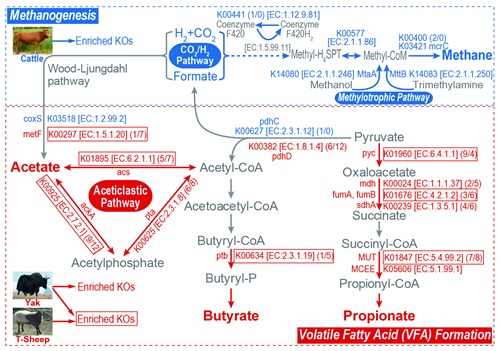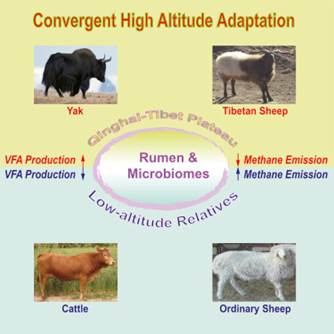


动物适应青藏高原极端环境的过程中,逐渐形成了耐低氧、耐高寒、耐粗饲料等复杂性状的适应性。以往针对高原适应遗传机制的研究大多数局限在动物自身遗传物质的变异,很少了解与动物宿主共进化的第二套基因组(即肠道微生物组)的重要贡献,特别是能量代谢方面。
中国科学院昆明动物研究所研究员施鹏领导的团队和中国科学院北京生命科学研究院研究员赵方庆团队以及兰州大学教授龙瑞军团队展开合作研究,以第二套基因组为新的切入点,基于“高效的能量产生与利用(短链脂肪酸是能量主要来源)和低的能量损耗(甲烷是瘤胃发酵的副产物,是能量主要损耗)有利于哺乳动物适应高原极端环境的长期胁迫”这一假设,借助两对物种之间的全面系统的比较,来探讨同域动物适应极端环境的肠道微生物组机制。研究发现,经历长期自然选择并很好适应高原极端环境的牦牛(Yak)产生的短链脂肪酸显著高于黄牛,甲烷排放显著低于黄牛;同样的规律在经历短期人工选择适应高原的藏绵羊(T-sheep)与低海拔的普通绵羊之间被发现。进一步通过瘤胃微生物宏基因组测序分析,发现了牦牛和藏绵羊在短链脂肪酸合成代谢通路的基因显著富集,黄牛在甲烷形成通路富集。通过比较牦牛和黄牛瘤胃粘膜转录组发现,牦牛短链脂肪酸运输和吸收相关的基因显著上调,表明了宿主和肠道微生物的协同进化,提示了高原动物自身也能够更好地吸收和利用瘤胃发酵产生的短链脂肪酸。
该研究报道了一个经典案例,发现了动物适应高原极端环境过程中宿主和微生物组的协同进化,是同域哺乳动物适应进化的必然选择之一。另外,发现的低甲烷排放的高海拔哺乳动物,为进一步通过生物调控策略缓解其他动物排放甲烷引起的温室效应具有重要的现实意义。该研究成果于6月17日在线发表在Current Biology (Convergent Evolution of Rumen Microbiomes in High-Altitude Mammals,Current Biology DOI: 10.1016/j.cub.2016.05.012)上,研究工作得到了中科院战略性先导科技专项(B类)和国家杰出青年科学基金项目的支持。(来源:中科院昆明动物研究所)
Convergent Evolution of Rumen Microbiomes in High-Altitude Mammals
Abstract Studies of genetic adaptation, a central focus of evolutionary biology, most often focus on the host’s genome and only rarely on its co-evolved microbiome. The Qinghai-Tibetan Plateau (QTP) offers one of the most extreme environments for the survival of human and other mammalian species. Yaks (Bos grunniens) and Tibetan sheep (T-sheep) (Ovis aries) have adaptations for living in this harsh high-altitude environment, where nomadic Tibetan people keep them primarily for food and livelihood [ 1 ]. Adaptive evolution affects energy-metabolism-related genes in a way that helps these ruminants live at high altitude [ 2, 3 ]. Herein, we report convergent evolution of rumen microbiomes for energy harvesting persistence in two typical high-altitude ruminants, yaks and T-sheep. Both ruminants yield significantly lower levels of methane and higher yields of volatile fatty acids (VFAs) than their low-altitude relatives, cattle (Bos taurus) and ordinary sheep (Ovis aries). Ultra-deep metagenomic sequencing reveals significant enrichment in VFA-yielding pathways of rumen microbial genes in high-altitude ruminants, whereas methanogenesis pathways show enrichment in the cattle metagenome. Analyses of RNA transcriptomes reveal significant upregulation in 36 genes associated with VFA transport and absorption in the ruminal epithelium of high-altitude ruminants. Our study provides novel insights into the contributions of microbiomes to adaptive evolution in mammals and sheds light on the biological control of greenhouse gas emissions from livestock enteric fermentation.
原文链接:http://www.cell.com/current-biology/fulltext/S0960-9822(16)30470-5



